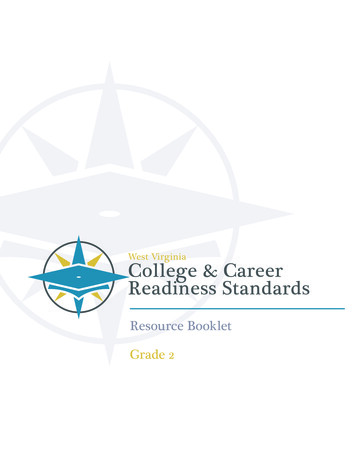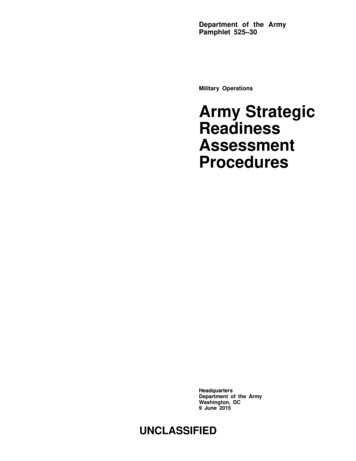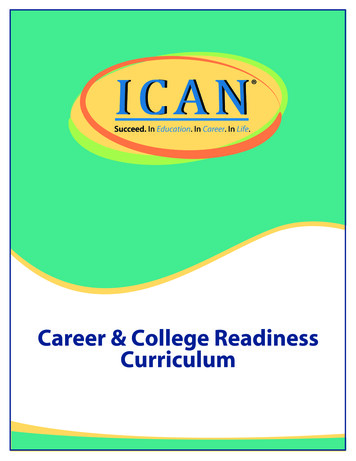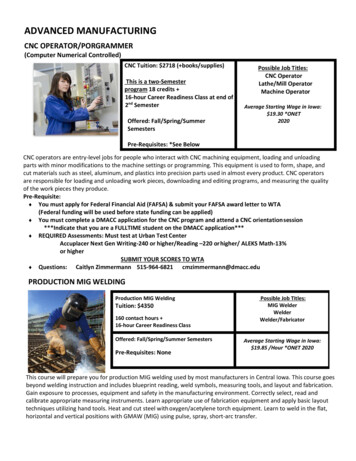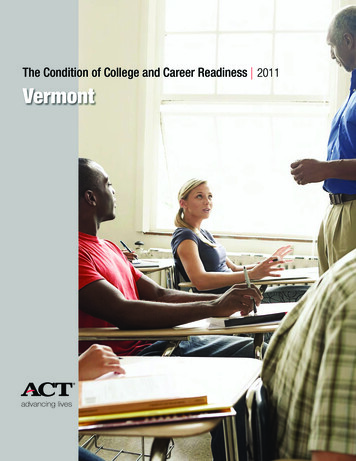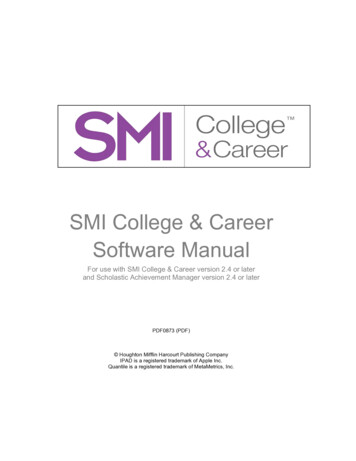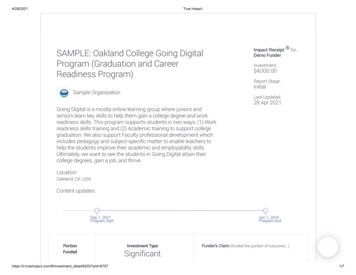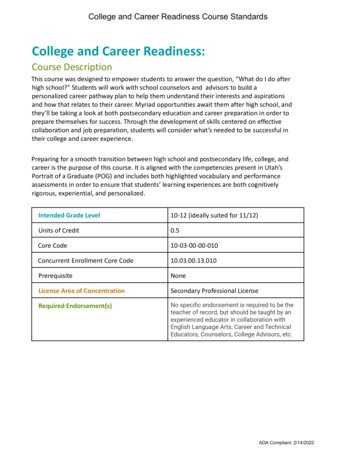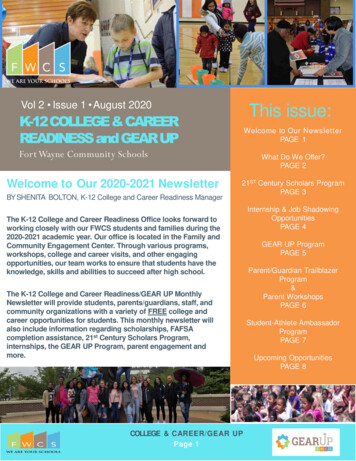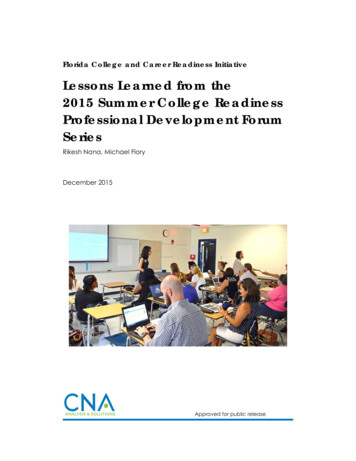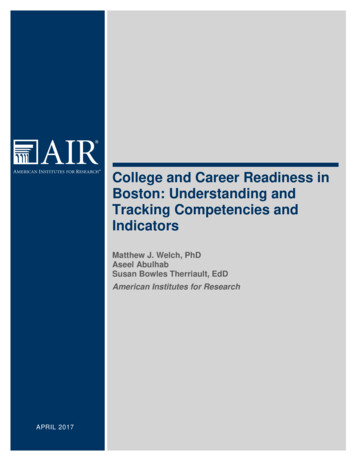
Transcription
College and Career Readiness inBoston: Understanding andTracking Competencies andIndicatorsMatthew J. Welch, PhDAseel AbulhabSusan Bowles Therriault, EdDAmerican Institutes for ResearchAPRIL 2017
College and Career Readiness inBoston: Understanding and TrackingCompetencies and IndicatorsApril 2017Matthew J. Welch, PhDAseel AbulhabSusan Bowles Therriault, EdDAmerican Institutes for Research1000 Thomas Jefferson Street NWWashington, DC 20007-3835202.403.5000www.air.orgCopyright 2017 American Institutes for Research. All rights reserved.
ContentsPageIntroduction . 1Findings. 2Academic Indicators . 2Soft Skills. 7Contextual and Social Indicators . 17Conclusions and Caveats . 20References . 21
IntroductionThe following is a review of research on college and career readiness indicators. Research oncollege and career readiness indicators is a vast field, examining a variety of indicators that relateto several different kinds of outcomes, including high school completion, college enrollment,college persistence, and obtaining gainful employment after school. These goals vary greatly, butstart from a similar place: students’ experiences during their high school years.The indicators we have compiled here are intended to offer guideposts for educators andcommunity program managers to consider in designing and measuring the success of theirprograms. This review was conducted and compiled by several researchers at AmericanInstitutes for Research (AIR) for partners at the Boston Opportunity Agenda.The review of research was conducted by searching online databases for evidence of indicatorsthat predict college and career readiness. The following databases were searched for peerreviewed articles: Academic Search Premier, ERIC, JSTOR, PsycINFO, and SAGE Journals,along with the collection of AIR’s own published information. Key words used in the searchincluded College Readiness, Career Readiness, College Indicators, Career Indicators, and a rangeof Employability Skills (with Employability and Skill listed as secondary and tertiary searchterms). The search terms were chosen by identifying key skills from different frameworks thatwere developed with the input of employers, educators, and researchers, such as theEmployability Skills Portfolio (Stemmer, 1992). Our inclusion of studies in this review focuseson work published in the last 15 years, though a small number of foundational studies in eacharea are cited as well.In addition to reviewing the published literature, AIR’s team conducted eight semistructuredinterviews with nine individuals with a diverse array of expertise in areas of college and careerreadiness, including foundation staff, university-based researchers, and experts from nonprofitand government agencies. These interviews revealed not only experts’ views on importantindicators of college and career readiness, but also their experiences in measuring emerging andchallenging constructs.American Institutes for ResearchBoston Opportunity Agenda Brief —1
FindingsBroadly speaking, our review was concerned with research that presented early indicators of latersuccess after high school, generally defined as preparation either for college or the world ofprofessional work. The indicators we found are presented in three categories: Academic indicators Soft skills, or employability skills Social and life experience indicatorsCollectively, these indicators show a wide variety of ways that high schools, school districts, andcommunity agencies might consider monitoring—and ultimately supporting—their students forgreater likelihood of success after high school. These various indicators describe a set ofcognitive abilities, noncognitive skills, experiences, and dispositions that might predict students’ability to thrive in a number of different circumstances in postsecondary life, though researchliterature generally focuses on these indicators being predictive of success in two realms: collegereadiness and career readiness. College readiness differs from college eligibility; in addition to satisfying high schoolgraduation requirements, college-ready students are able to succeed in a credit-bearingcourse at a postsecondary institution and, therefore, do not require any remediation(Conley, 2005, 2007a, 2010). Career readiness pertains to the knowledge, skills, and learning strategies necessary tobegin studies in a career pathway, or the basic expectations regarding workplace behaviorand specific knowledge necessary to begin an entry-level position (Conley, 2011b).Academic IndicatorsAcademic indicators are those that (a) center on a student’s formal schooling experience, and (b)are generally predictive of academic success (e.g., high school completion or collegepersistence). Unlike personal characteristics, academic indicators are often captured andmeasured in more accessible ways, particularly within high schools. Students’ grades, gradepoint average (GPA), or participation in early college experiences (e.g., dual enrollment) can betracked and quantified, often with readily accessible data. A summary of academic indicators ispresented in Table 1.Table 1. Overview of Academic Enrollment or Career andPersistenceWorkplace ResearchHigh School IndicatorsHigh SchoolCurriculumIntensity1. Defined as sufficient exposure tocore subjects, AP courses, andno remedial coursesAmerican Institutes for ResearchxRoderick,Nagaoka, &Coca (2009)Boston Opportunity Agenda Brief —2
OutcomePostsecondaryEnrollment or Career andPersistenceWorkplace ResearchIndicatorDescriptionHigh SchoolGPA/grades2. A student who maintains a Caverage or lower in high schoolis less likely than a student whomaintains above a C average(generally 3.0) to persist incollege. Findings from one study,which is not nationallyrepresentative, suggest thatstudents who have an A averageare seven times more likely tocomplete college in 4 yearscompared with students with a Caverage (Reason, 2009).3. Students who maintain a GPA ofC or lower were found to be lesslikely to persist in college whencompared with students whomaintains a GPA above a C(especially in the first year ofcollege), and the likelihood of astudent persisting decreased ashis or her GPA declined.4. According to a recent study,GPA is a better predictor ofcollege success thanstandardized test scores. It is aneven more powerful predictor ifstudents enter college within ayear of finishing high school. InAlaska, this holds true for bothurban and rural studentpopulations.x1. Dual-enrollment courses allowstudents to enroll in college-levelcourses (often for college credit)while still in high school.Sometimes dual- enrollmentprograms reflect a particularcareer pathway (e.g., health,technology). Students whoparticipate in dual-enrollmentprograms focused on careertype courses and located on acollege campus are more likelyto persist in college than similarstudents (attending college) whodo not. One possible reason forthis finding is that participating ina dual-enrollment programexposes high-schoolxDualEnrollmentAmerican Institutes for ResearchCabrera, Miner,& Milem (2013)Wolniak &Engberg (2010)Geiser &Santelices(2007)Hodara & Lewis(2017)D’Amico,Morgan,Robertson, &Rivers (2010)Hughes, Karp,Fermin, & Bailey(2005)Pierson,Hodara, & Luke(2017)Davis et. al(2017)Berger & Milem(1999)Boston Opportunity Agenda Brief —3
OutcomePostsecondaryEnrollment or Career andPersistenceWorkplace ResearchIndicatorDescriptionupperclassmen to the skillsrequired to be successful at thecollege level. In addition,students in early college highschool programs (a specific typeof dual-enrollment program) whoparticipate in college courses ona college campus are more likelyto be academically successful.2. Oregon’s rate of participation indual enrollment is high.Recently, studies showed thatdual enrollment that took placeat the college itself is a betterindicators of future collegesuccess than dual credit, whichconsists of college classes takenon the high school campus.3. In Minnesota, dual enrollment isassociated with higher rates ofcollege enrollment. For studentswho face more difficulties, suchas free or reduced lunch, theassociation is less clear.AdvancedPlacementResults1. A student who scores below a 3on an AP exam is less likely topersist in college than a studentwho scores a 3 or higher. Oneinterpretation of this finding isthat possessing a solidfoundation in content—asevidenced by success on APexams—is a critical componentfor success in college. Note: It issuggested that AP performancemay reflect habits of mind thatcontribute to college successand that students who accessAP courses throughnontraditional means may notpossess these samecharacteristics and may bereceiving supports that allowthem to be successful on APexams, but not necessarilyacquire the skills related topersistence.x1. Students who perform poorly oncollege entrance exams are lesslikely to persist in college thanxSAT ScoresAmerican Institutes for ResearchACT (2009)Conley (2007)Roderick,Nagaoka,Coca, & Moeller(2008)Ryan (2004)Boston Opportunity Agenda Brief —4
OutcomePostsecondaryEnrollment or Career andPersistenceWorkplace ResearchIndicatorDescriptionstudents who receive the highestscores on college entranceexams. Students with the highestSAT scores were found to be sixtimes more likely to graduatefrom college in 4 years thanstudents with the lowest scores.Note: The exact cutoff orthreshold for high versus lowSAT scores was not provided.End-ofCourseExams1. A student who scores below theproficiency level on an end-ofcourse exam in high school maybe at risk of not persisting incollege.xConley (2007)Participationin RemedialCourses1. Participation in remedial coursesin college is an indicator of riskthat a student may not persist incollege.xStewart, Lim, &Kim (2015)ArticulatedAcademicand CareerGoals1. A student who has few or pooracademic and career goals mayhave less probability ofcompleting college. This includeschoice of major and alignmentwith student goals.2. The data necessary to informthis indicator need to be clearlydefined. The research is basedon a survey of students. Theremay be data on the collegeapplication that could be used tocapture this information (e.g., astudent selects a major orapplies as undecided).xKahn & Nauta(2001)Titus (2004)Adelman (2006)St. John, Hu,Simmons,Carter, & Weber(2004)Pascarella &Terenzini (1980)Career and Vocational Technical Education (CVTE) thSatisfactoryRating1. Students have the chance tolearn and practice their skills inthe context of work.Presence ofCareerGuidancePrograms1. Students have access to careerguidance, especially assistancewith planning.American Institutes for ResearchxDarche & Stern(2013)Hanushek,Schwerdt,Woessman, &Zhang (2016)xKuijpers,Meijers, &Gundy (2011)Boston Opportunity Agenda Brief —5
American Institutes for ResearchBoston Opportunity Agenda Brief —6
Academic indicators are often discussed in terms of preparation for college. However, there alsoare ways to gauge students’ preparation for work in CVTE experiences. For example, thecompletion of different kinds of apprenticed work experiences correlates with higheremployment (see Darche & Stern, 2013). These can be experiences where students not only learnthe technical skills of a profession, but also gain some of the soft skills referenced in thefollowing section.Measuring Academic IndicatorsMassachusetts school systems have a strong record of tracking academic indicators. Forexample, state systems currently include the Early Warning Indicator System (EWIS) tool andrelated systems, which allow schools and districts to identify students who have missed a numberof school days that put them at risk or those students who are not accumulating a sufficientnumber of credits to put them on track to graduate (e.g., students must earn at least five credits inGrade 9). Several systems track completion of the MassCore (the Massachusetts high schoolprogram of studies), and encourage students to complete or exceed these requirements. Recentreports from Achieve (2016) also indicate that Massachusetts has information on cohortgraduation rates, college attendance and persistence, AP course performance, and preparednessfor careers in the military by performance on the U.S. Armed Forces enlistment examination.This same report from Achieve, as well as interview data, showed other areas where schoolsystems in Massachusetts should consider tracking additional information that is not commonlytracked, such as the following: Other advanced courses that students have taken, such as dual-enrollment and earlycollege experiences District-level tracking of completion of various precollege experiences that have shownto predict college persistence, such as taking the PSAT, completing the Free Applicationfor Federal Student Aid (FAFSA), and college visits. Interview participants noted thatguidance counselors can be utilized, when student-counselor ratios are reasonable, toensure that students complete these experiences and can assist with tracking them throughschool-created tools or software tools such as Naviance Quarterly examinations of course failures, absences, and other warning signs, beyond theannual screening using tools such as EWIS Measures of students’ sense of connection to high school, established through programssuch as advisories and mentoring, which can predict long-term college and career success(see Villavicencio, Klevan, & Kang, 2015; Faircloth & Hamm, 2004)Soft SkillsThe second category of indicators is the broadest and the one with the largest array of names. AsSavitz-Romer and her colleagues (2015) point out, terms for this group include soft,employability, noncognitive, metacognitive, and 21st century skills, among other terms.Interview participants agreed that “coming up with a common language in the field is a realneed.” For the purposes of this review, we have selected the term soft skills, as it was used byAmerican Institutes for ResearchBoston Opportunity Agenda Brief —7
some of the more recent studies reviewed here and because it most clearly implies that theseskills are applicable to several contexts, not just particular subjects or settings.By and large, these soft skills are not related to innate intellectual capacity, but rather represent alargely nonspecific and nonacademic set of traits that nonetheless can be valuable skills for successin a variety of areas, including both academic and professional work. Soft skills also are relevant tothis review as they are in demand, but difficult to cultivate and measure in many traditionalsettings. They “are ones that employers increasingly contend are vital to success in the work world,but are in short supply” (Savitz-Romer, Rowan-Kenyon, & Fancsali, 2015, p. 19).Soft skills represent an area that is both in practical demand, but also in early stages ofdevelopment in terms of monitoring and interventions. Two recent studies suggest priorities foreducators in this broad area that generally encourage development of soft skills that can supportsuccess in several contexts. Nagaoka, Farrington, Ehrlich, and Heath (2015) suggest that threekey factors for youth success are agency (taking an active role in development), integratedidentity (internal consistency across contexts), and competencies (abilities to perform complextasks such as critical thinking and collaboration). More recently, Gates and colleagues (2016)proposed three skills that contribute most toward positive development at the intersection ofworkforce success, violence prevention, and sexual and reproductive health. Similar to theNagaoka et al. study, these were self-control (similar to agency, this represented discipline andavoiding risk behaviors), positive self-concept (self-efficacy and confidence in different domainsof life), and higher-order thinking skills (problem-solving skills related to diverse, complextasks). Both studies suggested that these skills are foundational, and are most likely to contributeto varying kinds of social success and workplace advnacement.We have used these two recent studies to organize the many soft skills presented in this review.The soft skills—those that can correlate with either college readiness, career readiness, or both—are listed in Tables 2, 3, and 4. These indicators fall into three categories, inspired by the Gatesand Nagaoka studies: Agency: Soft skills related to self-discipline and self-control as well as one’s ability toreflect on progress and persist in completing a task; Identity: Soft skills related to one’s sense of self and confidence; and Competency: Soft skills related to critical thinking, problem solving, and transferringknowledge to other settings or problems.Table 2. Overview of Soft Skills: AgencyOutcomeSkillDescriptionSelf-Regulation2. Self-regulation, defined as theability to focus and exerciseinhibitory control, is a predictorof academic achievement.3. Interventions to improve selfregulation can significantlyAmerican Institutes for ResearchPostsecondaryAttendance orPersistencexCareerandWorkplacexResearchDuckworth &Seligman (2005)Dignath,Buettner, &Langfeldt (2008)Boston Opportunity Agenda Brief —8
OutcomeSkillConscientiousnessDescriptionimprove academicperformance, especially inmathematics.1. Conscientiousness is anaspect of personality, highlyrelated to “grit,” (perseverancein the pursuit of long-termgoals). Each has been shownto be at least as predictive ofacademic performance as IQ.Duckworth’s work operates onan emerging idea thatindicators such as these,related to personality, aremalleable.American Institutes for ResearchPostsecondaryAttendance uckworth,Heckman, &Kautz (2011)Duckworth,Peterson,Matthews, &Kelly (2007)Boston Opportunity Agenda Brief —9
sDescription1. Self-monitoring skills, relatedto self-assessment skills, arebuilt through practice in goalsetting and tracking progress.2. Self-monitoring is seen inconjunction with motivationand engagement, goalorientation and self-direction,self-confidence, metacognitionand self-efficacy, andpersistence. It is regarded asa key component of collegereadiness and an aspect ofagency.1. Grit is an aspect ofpersonality, highly related toconscientiousness. It isdefined as perseverance andpassion for long-term goals.Each has been shown to be atleast as predictive ofacademic performance as IQ.1. Particularly, this refers to theperseverance in the pursuit oflong-term goals. Similar to“grit” and conscientiousness, ithas been shown to be at leastas predictive of academicperformance as IQ.1. Positive mindsets aboutlearning and social belongingin academic environments arepredictive of academicperformance.2. Interventions aimed atimproving academic mindsetsresult in improved academicperformance. Suchinterventions can reverse thecommonly held misconceptionthat intelligence is fixed anddoes not grow with effort.3. Stereotype threat is apredictor of poor academicperformance. Interventions toreduce this effect arecorrelated with animprovement in academicperformance.American Institutes for ResearchPostsecondaryAttendance orPersistencexCareerandWorkplacexxxResearchConley &French (2014)Duckworth et al.(2007)Hanford (2012)xxGaertner &McClarty (2015)Radcliffe & Boss(2013)xxBlackwell,Tzesniewski, &Dweck (2007)Walton & Cohen(2011)Dweck, Walton,& Cohen (2014)Cohen, Garcia,PurdieVaughns, Apfel,& Brzutoski(2009)Boston Opportunity Agenda Brief —10
The first set of characteristics are related to personal agency, or a sense in people that they can exertinfluence on the events that shape their lives (see Bandura, 2001). These include concepts such asregulating desires and monitoring feelings or progress on a task. Related are the ability to pushoneself to complete a difficult task. These concepts are captured by the currently popular terms “grit”and “perseverance,” most notably inspired by the work of former classroom teacher AngelaDuckworth. These indicators, generally described as having the persistence and passion to pursuelong-term goals in the face of difficulty, can predict a variety of outcomes. Students demonstratingthese indicators are more likely to complete difficult, long-term objectives, including graduation.Table 3. Overview of Soft Skills: IdentityOutcomePostsecondaryAttendance or Career andPersistenceWorkplace ResearchSkillDescriptionMotivation1. Student motivation for learningis predictive of academicachievement.2. Students who are motivated bymastery of content demonstratebetter academic behaviors (e.g.,study skills) and overallacademic performance.3. Student valuations of a subjectand expectations for success arestrong predictors of theiracademic performance in thatsubject.4. Student motivation for learninggenerally declines over time andis most vulnerable during schooltransition years, especially duringthe transition to middle school.5. Interventions to improve studentmotivation are effective and canresult in better academicperformance.6. Individuals’ motivations withinwork often represent values thatare expressed through attitudesand could be learned skills, notsoft skills.x1. Self-efficacy is seen inconjunction with motivation andengagement, goal orientationand self-direction, selfconfidence, metacognition andself-monitoring, and persistence.Specifically, it refers to belief inone’s own ability to completexSelf-EfficacyAmerican Institutes for ResearchxWigfield &Eccles (2000)Cury, Elliot, DaFonseca, &Moller (2006)Conley &French (2014)Gaertner &McClarty (2015)Hafner, Joseph,& McCormick(2010)Hafner &McCormick(2013)Lazowski (2015)Mattern, Allen, &Camara (2016)Worth (2003)Eccles, Midgley,& Adler (1984)Dweck (1986)Elliot,McGregor, &Gable (1999)xConley &French (2014)Jiang (2016)Strayhorn(2015)Boston Opportunity Agenda Brief —11
tasks and/or goals. It isregarded as a key component ofcollege readiness.SelfConfidenceExercisesLeadership1. Self-confidence is seen inconjunction with motivation andengagement, goal orientationand self-direction, selfmonitoring, metacognition andself-efficacy, and persistence. Itis regarded as a key componentof college readiness.1. Related term includes StudentLeaders.Slade, Eatmon,Staley, & Dixon(2015)xxConley &French (2014)xBates & Phelan(2002)Rosenberg,Heimler, &Morote (2012)Casner-Lotto &Barrington(2006)Collet, Hine, &du y)1. Related terms include Ethicsand Integrity.xBates & Phelan(2002)Taylor (2005)Ju, Zhang, &Pacha (2012)Rosenberg etal. (2012)TakesResponsibilityforProfessionalGrowth1. Related terms include CareerDevelopment, ProfessionalGrowth, Selects Mentor, andResponds to Feedback.Self-Advocacy1. This refers to the process ofexercising, defending, andpromoting one’s rights—mostoften refers to people withdisabilities speaking and actingon behalf of themselves.2. The term “self-advocacy” in theresearch shows up largely inreference to students withdisabilities, though that does notmean that students withoutdisabilities could not benefitfrom improving this skill. Theresearch presented selfadvocacy as correlated withxBates & Phelan(2002)Zinser (2003)Collet et al.(2015)American Institutes for ResearchxGreen (2013)Green (2014)Olney &Salomone(1992)Boston Opportunity Agenda Brief —12
students with disabilities’success in finding andmaintaining employment, andnot necessarily in an academicsetting, though there is certainlya connection between selfadvocacy and collegereadiness.The second set of personal factors are related to identity and self-concept. Together, theydescribe a sense of confidence in abilities and self-efficacy to overcome obstacles of differentkinds. Such a sense of self-concept might allow a student to utilize similar strengths in a varietyof settings, maintaining a consistent sense of self throughout.Table 4. Overview of Soft Skills: . It is possible to explicitly trainindividual critical-thinkingstrategies.2. Critical thinking is an essentialprocess in the transfer ofknowledge, whereby studentsuse knowledge of skills learnedin one subject and apply it tosolve problems or advanceunderstanding in another.PostsecondaryAttendance or Career andPersistenceWorkplace ResearchxxKlauer & Phye(2008)Lombardi,Kowitt, &Staples (2015)Verrell &McCabe (2015)Soulé & Warrick(2015)Buskist (2016)Duvall & Pasque(2013)Halpern (1998)ProblemSolving1. Problem-solving skills are oftenbest learned within subjectspecific contexts (e.g., Englishlanguage arts and mathematics)and are somewhat restricted intheir applicability acrosssubjects.2. Problem-solving skills are apredictor of academicperformance.American Institutes for ResearchxxMayer &Wittrock (2006)Greiff et al.(2013)Duvall & Pasque(2013)Perkins &Salomon (1989)Boston Opportunity Agenda Brief —13
OutcomeSkillDescriptionCreativity1. It is possible to teach andimprove creativity. Althoughunder the category of criticalthinking and related in theresearch, creativity refers to theunique ways and the libertytaken in which students maycritically think in order to solve aproblem or complete a task orassignment.1. Applied academic skills includebasic communication skills (e.g.,reading, writing, speaking,listening), applying scientific andsocial studies concepts, andperforming mathematicalprocesses in work-relatedsituations.1. Related terms include WrittenCommunication, CommunicationSkills, and Writing.AppliedAcademicSkillsConveysInformation inWritingPostsecondaryAttendance or Career andPersistenceWorkplace ResearchxxScott, Leritz, &Mumford (2004)Soulé & Warrick(2015)xZinser (2003)xBates & Phelan(2002)Zinser (2003)Miller & Luse(2004)Deeley (2014)Pollack &Godwin (1983)TechnologyUse1. Related terms includeTechnology Skills and ComputerLiteracy.xBates & Phelan(2002)Miller & Luse(2004)Taylor (2005)Rosenberg,Heimler, &Morote (2012)SystemsThinking1. Systems thinking is “the abilityto understand (and sometimesto predict) interactions andrelationship in complex, dynamicsystems: the kinds of systemseducators are surrounded byand embedded in” (Senge et al.,2000, p. 239).American Institutes for ResearchxRosenberg et al.(2012)Yurtseven &Buchanan(2016)Betts (1992)Boston Opportunity Agenda Brief —14
The final group of personal indicators relates to students’ critical-thinking skills, including theability to transfer cognitive problem-solving skills to various kinds of academic and careersituations (Kuncel & Hezlett, 2010). Several sources describe these traits as malleable, trainablecharacteristics (e.g., Savitz-Romer & Bouffard, 2012). Students demonstrating these indicatorswill, for example, be able to transfer knowledge to new settings and use knowledge in solvingnovel problems.Measuring Soft SkillsAlthough these personal characteristics are likely to be of great interest to educators, teachingand measuring these characteristics are challenging for educational and community institutions.Measures are often specific, proprietary instruments, the use of which may impose costs on usersand also may require training for valid use. Instruments meant to measure soft skills also may belimited in scope to discrete concepts or not designed to measure growth over time.In terms of workplace application, pertinent employability skills for career readiness and successare measured largely through surveys to employers, educators, students, or employees themselves.Academically, there has not been a convergence to date of evidence or expert opinion on a singletype of assessment getting at several kinds of soft skills, making this type of information difficultto obtain (Archambault et al., 1993; Lockwood, 2007). Teacher assessments aimed at identifyingstudents with these traits are one possible avenue. For example, assessments can be measures ofacademic knowledge as well as tools to assess underlying student traits (e.g., motivation,communication, or organization skills), which are found to be significant contributors tostudents’ success in advanced courses. However, such tools are often time consuming or requirean investment in training of teachers to ensure valid measurement.Interviews with experts in this area have revealed several findings relevant to school systems andcommunity partners trying to measure and influence so-called soft skills. First, measurement of theseskills can be challenging. One participant noted, “There are not a lot of good assessments out there,so the field certainly has a lot of need to fill in the gap in terms of how do we measure these kinds ofsocial-emotional outcomes for students.” Interview participants noted several formal instruments thathave been used to measure soft skills as well as several other ways that they or programs they hadstudied were trying both to assess and support the development of soft skills in students.Interview participants described their experience with several formal, research-based instrumentsmeant to measure soft, noncognitive skills. These have included the 5Essentials Survey,Duckworth’s Gri
1. Dual-enrollment courses allow students to enroll in college-level courses (often for college credit) while still in high school. Sometimes dual- enrollment programs reflect a particular career pathway (e.g., health, technology). Students who participate in dual-enrollment programs focused on career-type courses and located on a
